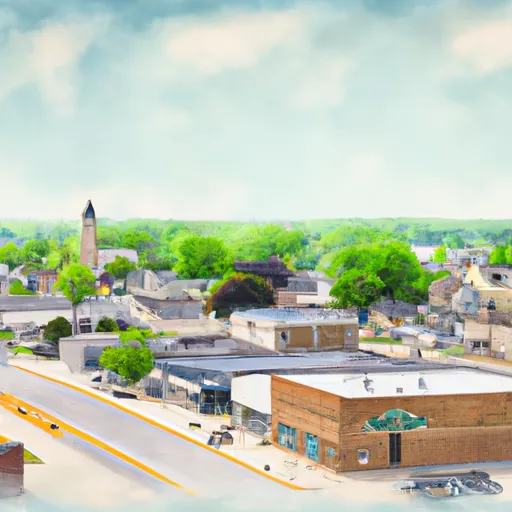-
 Snoflo Premium
Snoflo Premium
Get unlimited access to all our content
With no Ad interruptions! - Start Your Free Trial Login with existing account
La-Porte
Eden Index
Climate
8.0
•
Recreation
4.2
•
Community
2.3
•
Safeguard
5.2/10

La Porte, Indiana, located in LaPorte County, offers a diverse climate with all four seasons. Summers are warm and humid, with average temperatures ranging from 70°F to 85°F. Winters, on the other hand, are cold, with average temperatures between 20°F and 35°F, accompanied by moderate snowfall. Spring and fall bring mild temperatures and are considered pleasant periods.
The city is home to several hydrological constituents, including a system of lakes, rivers, and creeks. Pine Lake, Clear Lake, and Stone Lake are popular destinations for fishing, boating, and swimming. Pine Creek and Galena Creek are scenic waterways that provide opportunities for kayaking and canoeing enthusiasts.
Outdoor recreation opportunities in La Porte are abundant. The area boasts numerous parks and natural areas, such as Soldiers Memorial Park and Creek Ridge County Park, providing hiking and biking trails, picnic areas, and playgrounds. Luhr County Park is a beautiful destination for birdwatching, with its extensive wetlands attracting a variety of avian species. Additionally, local golf courses, like Beechwood Golf Course, offer opportunities for golf enthusiasts to enjoy the game amidst picturesque surroundings.
What is the Eden Index?
The Snoflo Eden Index serves as a comprehensive rating system for regions, evaluating their desirability through a holistic assessment of climate health, outdoor recreation opportunities, and natural disaster risk, acknowledging the profound impact of these factors on livability and well-being.
Climate Health Indicator (CHI): 8.0
La-Porte receives approximately
1065mm of rain per year,
with humidity levels near 82%
and air temperatures averaging around
10°C.
La-Porte has a plant hardyness factor of
6, meaning
plants and agriculture in this region thrive during a short period during spring and early summer. Most
plants will die off during the colder winter months.
By considering the ideal temperature range, reliable water supplies, clean air, and stable seasonal rain or snowpacks, the Climate Health Indicator (CHI) underscores the significance of a healthy climate as the foundation for quality living.
A healthy climate is paramount for ensuring a high quality of life and livability in a region, fostering both physical well-being and environmental harmony. This can be characterized by ideal temperatures, reliable access to water supplies, clean air, and consistent seasonal rain or snowpacks.
Weather Forecast
Streamflow Conditions
Upper Illinois
Area Rivers
Upper Illinois
Snowpack Depths
Upper Illinois
Reservoir Storage Capacity
Upper Illinois
Groundwater Levels
Recreational Opportunity Index (ROI): 4.2
The Recreational Opportunity Index (ROI) recognizes the value of outdoor recreational options, such as parks, hiking trails, camping sites, and fishing spots, while acknowledging that climate plays a pivotal role in ensuring the comfort and consistency of these experiences.
Access to outdoor recreational opportunities, encompassing activities such as parks, hiking, camping, and fishing, is crucial for overall well-being, and the climate plays a pivotal role in enabling and enhancing these experiences, ensuring that individuals can engage in nature-based activities comfortably and consistently.
Camping Areas
| Campground | Campsites | Reservations | Toilets | Showers | Elevation |
|---|---|---|---|---|---|
| Tipsaw | 50 | 576 ft | |||
| Martin State Forest | 25 | 743 ft | |||
| Newton Stewart State Rec Area - Patoka Lake | 500 | 728 ft | |||
| West Boggs Park | 220 | 528 ft | |||
| Celina Recreation Area | 55 | 709 ft | |||
| Crane MWR Military | None | 594 ft | |||
| Saddle Lake Rec Area | 13 | 589 ft | |||
| Springs Valley Rec Area | 10 | 672 ft | |||
| Dubois County Park | 32 | 575 ft | |||
| Ferdinand State Forest | 70 | 489 ft |
Nearby Ski Areas
Catastrophe Safeguard Index (CSI):
The Catastrophe Safeguard Index (CSI) recognizes that natural disaster risk, encompassing floods, fires, hurricanes, and tornadoes, can drastically affect safety and the overall appeal of an area.
The level of natural disaster risk in a region significantly affects safety and the overall livability, with climate change amplifying these risks by potentially increasing the frequency and intensity of events like floods, fires, hurricanes, and tornadoes, thereby posing substantial challenges to community resilience and well-being.
Community Resilience Indicator (CRI): 2.3
The Community Resilience Indicator (CRI) recognizes that education, healthcare, and socioeconomics are crucial to the well-being of a region. The CRI acknowledges the profound impact of these elements on residents' overall quality of life. By evaluating educational resources, healthcare accessibility, and economic inclusivity, the index captures the essential aspects that contribute to a thriving community, fostering resident satisfaction, equity, and social cohesion.

